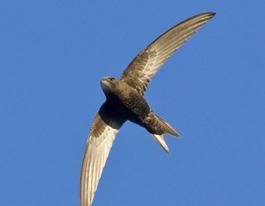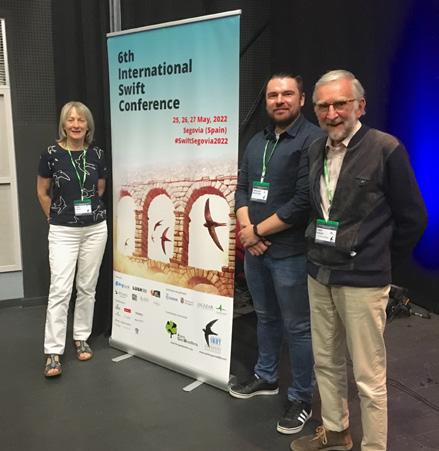
5 minute read
From Administrator to Swift Whisperer
Retired ATU administrator Lynda Huxley talks to us about the Swift and the ATU Swift Nest Box Project
Tell us about the Swift.
Swifts are extraordinary birds. They are the fastest bird in Ireland’s skies and can reach speeds of around 200 km per hour. They are often confused for Swallows or House and Sand Martins. The Swift’s sickle-shaped wings and dark underparts distinguish it in flight from Swallows and Martins.


The Swifts come to Ireland each year from mid-April to early September to breed, lay their eggs and rear their young.
They spend our winter months in Southern Africa. They go to Southern Africa because the insect food is prolific there from October to March.
What do they eat?
They feed on air borne insects, one of their favourites is the midge. They collect the food whilst flying and funnel the insects into their wide-open mouth with the help of stiff bristles that surround the gape.
When the Swifts are here in summer, each pair will consume over half a million insects so a healthy environment free of pesticides is essential to provide enough airborne insects for their food and for their survival.
How do they breed?
Swifts only land for the breeding process. They reach breeding age when they are around three years old. Until then they fly 24 hours a day, seven days a week.
The birds that are of breeding age and have a partner and will spend each night of the breeding season in the nest site.
Where do they nest?
These days, Swifts nest almost exclusively in old buildings in our towns, villages and cities. Before this, they would nest in holes in trees or in cliff faces. There are still some Swifts nesting in cliffs in Co. Antrim and Co. Sligo.
Why have we seen a big decline in the Swift population?
Ireland has seen a dramatic decline of close to 50% of its breeding population in the past 40 years and this is mostly due to loss of their ‘traditional’ nest sites in old buildings in our urban areas.
Nest sites are often lost when buildings are renovated or demolished. Swifts are 100% faithful to their nest site and their partner. If they lose their home, it can take several years for them to find a new home and during that intervening period they will not breed.
Why should we protect Swifts?
• They are an important part of our urban biodiversity – built and natural heritage. Over 90% of nest sites are found in our villages, towns and cities.
• Ireland is their home – they only breed when they are here and not when they are in Southern Africa.
• A fossil found in Germany shows that they have been around for 49 million years. We should not let them become extinct when we have it in our power to protect them.
• There is no legal protection for the nest sites outside of the breeding season.
What can we do to protect the Swift?
We can give them secure, longterm nesting sites and ensure our environment remains healthy by not using pesticides that kill their insect food.
Tell us about the Swift nest box project at ATU Mayo.
The first public Swift nest box project in Ireland was set up at ATU (then GMIT) Mayo campus in 2012 as part of its Green Campus Biodiversity Themed Projects.
There were originally 12 nesting compartments, expanded to 18 in 2019, each equipped with an infra-red analogue camera. This enables 24/7 live-streaming during the breeding season via the ATU website.
Has the nest box project at ATU Mayo had an impact on the Swift population?
In 2022, the ATU Mayo campus nest box project was home to 12 pairs of breeding Swifts. In addition to the external nest boxes at the Mayo campus, there are also 23 built-in nest boxes at the ATU wing of the new Castlebar Leisure Centre.
In 2022 we noted that 18 of these built-in nest boxes were occupied by Swifts making the ATU combined nest boxes projects the most successful in Ireland.


Pictured left to right: Lynda Huxley, Jarek Majkusiak and Chris Huxley.

